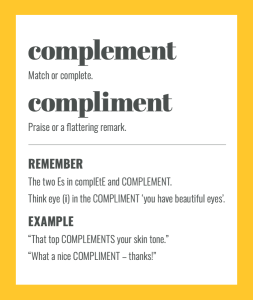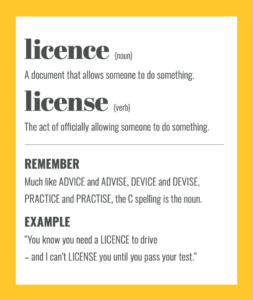Complement vs compliment: spelling tricks to help you decide
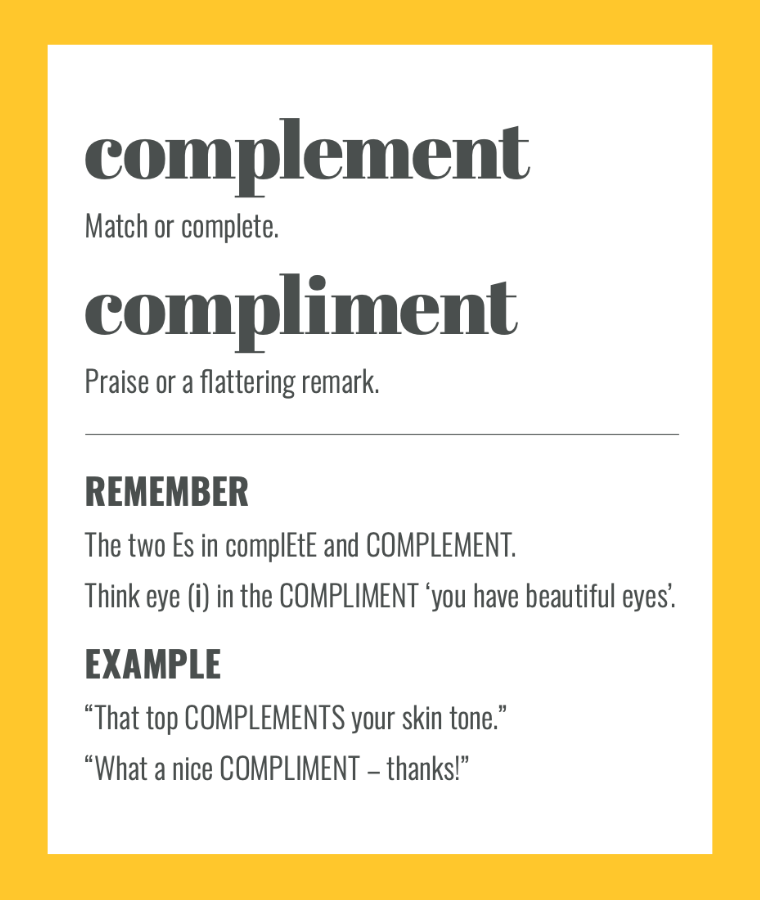
COMPLEMENT or COMPLIMENT: top spelling tips to help you remember the difference.
COMPLEMENT or COMPLIMENT – they sound the same but their meanings are very different.
So, what do these words mean – and how do you decide which spelling you need? It’s easy.
These simple spelling tips will help you decide whether you need the word COMPLEMENT or COMPLIMENT.
Complement
COMPLEMENT means to complete or match with something.
For example:
“This wine complements the dish.”
Remember the e of complete.
Compliment
Spelled with an i, a COMPLIMENT is a flattering remark or praise.
For example:
“You have lovely eyes” – think eye/i.
Complementary vs complimentary
When it comes to COMPLEMENTARY and COMPLIMENTARY, these meanings follow suit:
If something is complementary it completes the set, or matches…
“The room was furnished using complementary colours that matched the decor.”
…while a complimentary remark is a flattering statement.
“He was complimentary about my dancing.”
Note that the spelling complimentary has a second meaning. It also means free, like this:
“Help yourself to a complimentary drink”
I hope these tips help you to remember the difference between COMPLEMENT and COMPLIMENT.
Get more tips in The Little Book of Confusables
Licence vs license: top spelling tricks to help you get it right
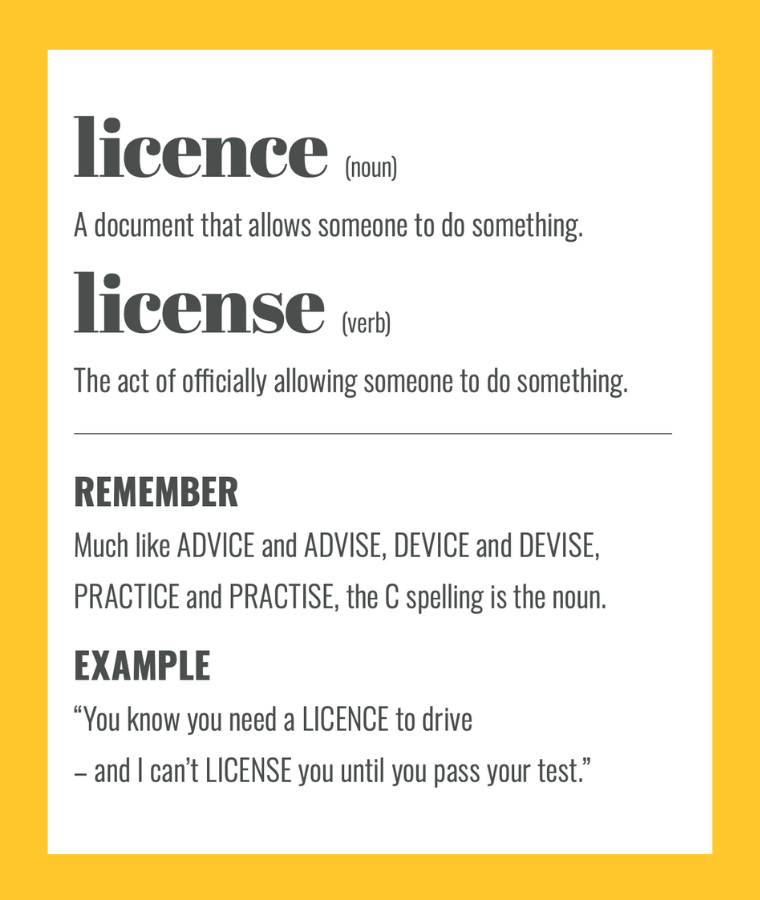
LICENCE vs LICENSE: simple tips to remember the difference
LICENCE and LICENSE are easy to confuse. The fact that both words sound the same trips people up time and time again.
Here are my simple tips to remember the difference between LICENCE and LICENSE*
When to use LICENCE
LICENCE is a noun.
You need a licenCe to drive a Car.
Also, remember that a licenCE is printed on paper, like a CErtificate.
When to use LICENSE
LICENSE is a verb that means to give permiSSion.
Remember the S in licenSe and permiSSion.
*Important note – in the US, both the verb and the noun are spelled LICENSE.
PRO TIP
If you know the trick for PRACTICE vs PRACTISE – remembering that ICE is a noun – you can apply the same C vs S spelling rule here.
You can also apply this spelling tip to other similar pairs, such as ADVICE and ADVISE or DEVICE and DEVISE.
Just remember, the suffix ICE means the word is a noun.
Get more tips in The Little Book of Confusables
Two become one: compound words and how to use them

In the process of writing a brochure for a financial services client, I found myself with a dilemma. Do I write healthcare, health-care or health care?
Ahh, those tricky compound words… are they one word, two words or hyphenated?
Let’s start at the beginning.
What is a compound word?
A compound word occurs when two or more words are joined to create a new or combined meaning.
There are three types of compound word:
- open compounds
- closed compounds
- hyphenated compounds
Open compounds, closed compounds and hyphenated compounds: what’s the difference?
What is an open compound word?
Open compounds are written as two separate words. Here are some examples:
- ice cream
- door frame
- full moon
- dining table
- coffee mug
- phone call
- test tube
- first aid
What is a closed compound word?
Closed compounds are written as one word, like this:
- sunflower
- toothbrush
- moonlight
- fireplace
- notebook
- flowerpot
- redhead
- teacup
What is a hyphenated compound word?
A hyphenated compound occurs when two or more words are joined by one or more hyphens. Here are some examples:
- self-confidence
- mother-in-law
- check-up
- train-spotter
- half-mast
- pre-dinner
- non-starter
- ex-husband
The tale of the incredible disappearing hyphen…
Many words that begin as hyphenated compounds become so commonplace that the hyphen ends up being dropped – it’s a natural part of the evolution of the English language.
For example, all these words started off with a hyphen (and some dictionaries still use one):
- online
- mindset
- proofreader
- secondhand
According to a 2007 article published by Reuters, the OED dropped 16,000 hyphens in its sixth edition of the Shorter Oxford English Dictionary.
Some hyphens disappeared from compound nouns, which became a single word (for instance, pigeon-hole became pigeonhole, chick-pea became chickpea and bumble-bee became bumblebee) while other compounds, such as ice cream and test tube lost their hyphen and became two words.
In the article, the dictionary’s editor, Angus Stevenson, explains that the hyphen’s demise reflects current usage: “We have been tracking this for some time and we’ve been finding the hyphen is used less and less.”
Care to make any predictions on what could be next? With the growth of online shopping, I predict that next-day – in the context of next-day delivery – will become nextday. Sure, it looks wrong now, but give it five years
Using hyphens in compound adjectives
When two words are joined to modify a noun (forming a compound adjective) and are placed before the noun, they’re usually hyphenated, but take care – when the same two words are placed after the noun, they don’t need a hyphen.
For example:
- “Benefit from a tax-free lump sum” BUT “the proceeds are tax free”
- “Fresh from our in-store bakery” BUT “you’ll find bread in store”
- “She has a long-term illness” BUT “her symptoms will improve in the long term”
Advanced tip
An exception to this rule applies when the compound adjective is formed using an adjective that ends -ly, in which case it’s always written as two separate words with no hyphen.
Here are some examples:
… a successfully applied formula
…a newly formed group
…a widely used tool
Compound words vs portmanteau words
So, is a compound word the same as a portmanteau*?
Nope. Here’s why.
Sometimes called a blend, a portmanteau is a new word that’s formed from part of one word and part of another, like this:
Brunch = breakfast + lunch
Sitcom = situation + comedy
Smog = smoke + fog
*According to the OED, Lewis Carroll was the first to use the term portmanteau in this way in Through the Looking-Glass (1871). Here, Humpty Dumpty explains to Alice the portmanteau word, in which “two meanings are packed up into one word”. (His description comes from portmanteau – a large bag – which is itself a blend of the words porter and mantle.)
Compound words in British English vs US English
In the process of researching this article, I came across many words spelled differently in different dictionaries. Generally speaking, British English dictionaries tend to be more cautious – clinging on to the hyphen (mouth-watering) when US English has dropped it (mouthwatering).
So, if you’re not sure of the current recommended spelling of a compound word, check your favourite online dictionary. Just don’t be surprised if they don’t always agree…
8 quick and dirty tips to help you write better emails

These 8 tips will help you write better emails, and get better results from those everyday messages.
Hands up if you love writing emails?
Thought not.
Yet you probably write dozens of functional emails every day.
Before I share my advice for writing emails that get results, I’m going to be controversial: pick up the phone.
Sometimes it’s easier, quicker, and all-round more efficient to have a two-minute chat than it is to spend time struggling for the best way to give feedback, make plans, or express your feelings in writing.
Convinced email is the best method for what you need to say?
Then let’s crack on.
(Note: I’m not here to tell you how to write cunningly convincing sales campaigns – that’s a whole other blog post. Get in touch if you need help with that.)
1: Grab attention
The subject line is the place to summarise the content and objective of your message, so don’t leave it blank.
Be clear on what your message is about, right here.
2: It’s the end where we begin
How many times have you finished reading a long, rambling email only to realise you’ve no idea what the sender wants you to do? Pretty frustrating, eh?
Before you start writing, be crystal clear about your goal.
What action do you want your reader to take after reading your message?
This will help to focus your writing and write better emails.
3: Get to the point
Your readers are busy people – don’t waste their time. A little planning goes a long way.
Imagine you’re telling your customers about a launch event for a new product that could really help them. What do you need them to know?
As well as giving them a teaser of the benefits of the product, to raise their interest, they’ll need to know where and when the event is taking place, whether it’s free or paid for, plus other information such as a link for directions and the fact that parking is free at the venue.
Think about summarising the key points of your message upfront.
Include the who, what, when, where, why and how in the first paragraph, if you can.
4: Keep it short
We’re all suffering from information overload. Your message needs to cut through the chatter – so keep it brief.
Use short, punchy sentences and paragraphs. Make every word count. Avoid filler words that add nothing, like THAT, JUST, REALLY and VERY.
❌ “I JUST thought THAT I’d write to suggest THAT we meet up to discuss the project further.”
✅ “Let’s meet to discuss next steps.”
5: Keep it simple
Use clear language and plain English. Avoid business speak, buzzwords and jargon. They’re meaningless to your customers and create a distance between you and your reader.
As a general rule, if you wouldn’t say it in person, don’t write it in an email.
❌ “We would be delighted to assist you in this matter.”
✅ “We’d love to help.”
❌ “We apologise for any inconvenience caused.”
✅ “We’re sorry.”
6: Know your audience
The most powerful and persuasive emails are those that address the fears and desires of your audience – because it’s these that motivate them to take action.
Think of your writing as a one-to-one conversation with your audience. It’ll help you to get inside their head, as well as getting the tone right.
As Nelson Mandela famously said, “If you talk to a man in a language he understands, that goes to his head. If you talk to him in his language, that goes to his heart.”
7: Include a clear call to action
Make it blindingly simple for your reader to take action.
Avoid giving them too many choices – information overwhelm is one of the main reasons emails go unanswered.
Instead, guide them gently but firmly to act.
- Need to book a conference call? Suggest a couple of alternative times for the recipient to choose from.
- Providing a quote for a piece of work? Tell them you’ll follow up with a phone call in two days.
- Want your reader to book tickets for your event? Include a link to the booking page.
8: Check, check and check again
Check your language, spelling and punctuation. Read what you’ve written out loud – or get your computer to read it to you. You’d be surprised how easy it is to hear mistakes you can’t see.
Don’t rely on spellcheck as a substitute for proofreading. Spellcheck doesn’t know if you’ve repeated a word, or left one out; neither does it know if you’ve used the right word.
Beware of homophones – words that sound the same, but have different spellings and different meanings – such as:
- your, you’re
- to, too, two
- there, they’re, their
- sight, site
- board, bored
I call these #confusables – and you’ll find 600 confusing words demystified in 300+ fun, gorgeous and indispensable pages for just over a tenner, in my The Little Book of Confusables.
In summary…
Keeping your audience and your goal in mind from the off will help you write better emails. You’ll soon start getting better results from those everyday messages.
Let me know how you get on.
How to use apostrophes: your guide to apostrophe mastery!
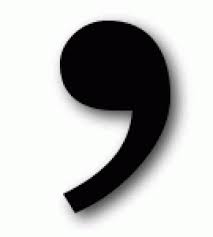
Need a beginners’ guide to using apostrophes? You’re in the right place…
No punctuation mark gets people as hot under the collar as the humble apostrophe.
People message me daily with examples of misplaced apostrophes (“Saw this and thought of you…”).
I even created #apostroppy to share uses of apostrophe abuse across social media.
Ultimately, mocking apostrophe misuse – or getting wound up by imposter apostrophes (impostrophes?!) – doesn’t help if you’re one of the many who finds it tricky knowing where to stick the little blighters.
Like most things in life, it’s easy when you know how.
And if you don’t know how, let me show you.
Here’s my beginners’ guide to apostrophes… and where to stick them.
What apostrophes do
In a nutshell, apostrophes have two main uses:
Contractions
This is where two words are squished together to sound more informal – like when you are becomes you’re.
Possession
This is where you want to show that X belongs to Y – the dog’s blanket, for example.
How to use apostrophes in contractions
Let’s start with contractions.
When we talk, we naturally blend words to sound more casual and conversational, like this:
- don’t rather than do not
- you’ll rather than you will
- I’m rather than I am
- it’s rather than it is
These shortened forms are called contractions. The apostrophe fits into the contraction to show where letters are missing – simple as that.
More examples of how apostrophes work in contractions
- I would = I’d
- she would = she’d,
- you would = you’d
- I am = I’m
- she is = she’s
- you are = you’re
- I will = I’ll
- she will = she’ll
- you will =you’ll
- does not = doesn’t
- is not = isn’t…
You get the picture.
How to use apostrophes to indicate possession
This is where things get a little more tricky. Possessive apostrophes show that a thing (a noun) belongs to something or someone.
Here’s the basic rule:
When the noun is singular – dog, writer, shop – you add apostrophe + s, like this:
- The dog’s blanket
- The writer’s pen
- The shop’s opening hours
When the noun is plural – there’s more than one of them – the word usually (not always) ends with s. When this is the case, you add the apostrophe after the s, like this:
- The dogs’ blankets
- The writers’ pens
- The shops’ opening hours
Remember I said usually? That’s because some plural nouns don’t end with s, like this:
- One child, two children
- One woman, two women
When that’s the case, just add apostrophe + s, like this:
- The children’s toys
- The women’s shoes
A simple tip for using possessive apostrophes
If you’re in any doubt where to put the apostrophe when you’re indicating possession, just turn the phrase around in your head, like this:
The toys belonging to the child = the child’s toys
The toys belonging to the children = the children’s toys
(Never, ever write the childrens’ toys. That would mean = the toys belonging to the childrens, which is wrong.)
How to use possessive apostrophes in names that end in s
Style guides differ in their guidance on whether to write Charles’ or Charles’s, Dickens’ or Dickens’s and the like. Here it’s okay to pick the one that sounds best, as long as you use it consistently throughout your document.
Just don’t make the mistake a Northern Ireland council made, when they wrote Charles Dicken’s Great Expectations instead of Charles Dickens’ Great Expectations.
Reprinting the giant advertising poster cost taxpayers over £1,000.
It’s vs its: why possessive pronouns are the exception to the rule
One of the most common apostrophe mistakes is sticking an apostrophe in the word its to show something belongs to IT.
But this rule doesn’t apply to pronouns – its, yours, his, hers, ours, theirs.
It’s is always a contraction of it is or it has.
ALWAYS.
Its describes something that belongs to it.
Like this:
- the dog chased its tail
- the cat drank its milk
When do plurals need an apostrophe?
Absolutely never.
You’ve heard of the grocers’ apostrophe, right? Most commonly spotted on market stalls advertising BANANA’S, APPLE’S and PLUM’S , those grocers are completely wrong.
Because you should never – I repeat, NEVER – use an apostrophe in plural words.
No exceptions.
- Cats, pens, teachers, apples, words… no apostrophe.
- Even when the word ends in a vowel: tomatoes, potatoes, videos… still no apostrophe.
- Even when the word is an abbreviation: CDs, DVDs, MOTs… still no apostrophe.
It’s a simple rule, and there are no exceptions to trip you up.
No matter how many times you see an apostrophe intended to show that there’s more than one of something, it’s always wrong. Always.
So, there we have it. Your beginners’ guide to using apostrophes.
I never said it would be short!
Want more information on how to use apostrophes?
This article covers the basics of how to use apostrophes.
Want to read more? Treat yourself to a copy of The Little Book of Confusables or check out the following articles:
Tips to remember the difference between ITS and IT’S
YOUR or YOU’RE? Simple tricks to get it right every time
LET’S vs LETS: when to remember the apostrophe
Using apostrophes in time expressions
Phrases such as two weeks’ time, six weeks’ holiday, and one day’s notice need an apostrophe.
I cover the rule for using apostrophes in time expressions in this article:
Don’t get caught out by the apostrophe in time expressions
**This is a guide for beginners (plural) so the apostrophe goes after the S. You could argue that you’re a beginner and it’s your guide, and therefore the apostrophe should come before the S. And you’d be right, but as it’s intended for more than one of you, we’ll stick with convention.
PRO TIP: one old-school rule you can ignore
Way back when, it was common practice to use an apostrophe to show an abbreviation – telephone was abbreviated to ‘phone, for example. Thankfully, you no longer need to worry about this archaic type of apostrophe use.


